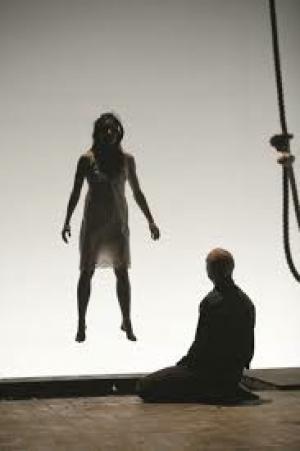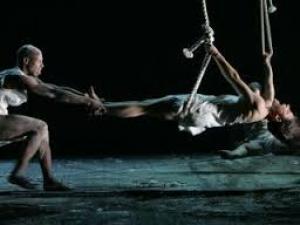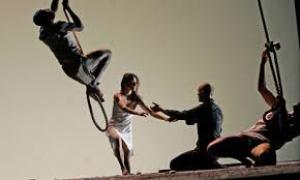Giselle (2003)
Fabulous Beast Dance Theatre
Duration: 90’
electronic score, with Angelo Smimmo (counter tenor), Daniel Mullin (violin), and Patrick Jones (cello)
Directed and Choreographed by Michael Keegan-Dolan
Designer: Sophie Charalambous
Lighting Design: Adam Silverman
Sound design: Mick Canney
Co-produced by Fabulous Beast with Dublin Theatre Festival. First performed at the Samuel Beckett Theatre, Dublin, September 2003.
Original Cast: Bill Lengfelder, Simon Rice, Mick Dolan, Daphne Strothmann, Neil Paris, Milos Galko, Benito Vladislav Soltys, Emmanuel Obeya, Christopher K Morgan, Angelo Smimmo
Michael Keegan-Dolan’s critically acclaimed interpretation of the story of Giselle, which was nominated for an Olivier Award, relocates the story to the Midlands of Ireland. In a production that is harsh and uncompromising, yet also funny and ultimately iridescently beautiful, the tale is told, despite the presence of a narrator, by the whole company of performers in speech and song as well as movement.
Like its romantic ballet precursor, Giselle is divided into two acts; the first is fast paced, propelled by text and action, but it is in the second, where there is no spoken word and the piece becomes predominantly a dance piece, that Keegan-Dolan’s genius for creating stay-with-you-for-life images is given full rein. In fact it even at points becomes an opera, as in the wilis scene, where Angelo Smimmo’s haunting counter tenor voice sings an evocative setting of the libera me from the liturgy of the Mass for the Dead.
Giselle was created over a period of five weeks in the cloistered residential surroundings of the Shawbrook School of Dance, run by Philip and Anica Dawson. This creative seclusion allowed for a remarkably focussed environment, and facilitated a real collegiate creative process, with the predominately male cast being able to immerse themselves in the aura of the piece, and indeed the aura of the place. Place is important; when Keegan-Dolan suggested the importance of visiting Shawbrook in order to experience the bleakness of the boglands and the leaden climate, the weather was cantankerously glorious.
However Shawbrook did find its way into the score. Most of the clonks and dark gongs that signal moments in the decline of Giselle McCreedy originate from the big water tank at Shawbrook, with one of the dancers, Benito Soltys, bashing it with a sledgehammer in one of the more unusual recording sessions you might imagine. Also, over this period, the rehearsals were conducted against the faint background noise of the water tank. For the majority of Act 1, a separate soundscape is played, constructed out of processed collage of the tank’s sounds; it creates a faint sense of unease and disorientation, and when it stops, or more accurately, is taken out, during the sparse intimate duet between Giselle and Albrecht (Strothmann and Galko), there is a sudden inexplicable sense of emptiness.
Just as The Flowerbed and The Christmas Show, the score is run off two minidiscs, being cued at the visually correct moment rather than at musical points, making it quite a complicated show for the sound operator. For the most part in act 1 the cues are all single cues, but all the cues in act 2 are crossfades, with the music being so structured that scenes can either blend seamlessly into the next, or crash in strongly, overriding the previous scene. This explains the extraordinary organic feel of the act, but also gives great flexibility to Keegan-Dolan’s virtuoso performers in their emotionally honest re-telling of the tale.
The track is a blend of live string playing, and electronically processed strings. The powerful overture is almost entirely constructed out of aggressive cello phrases, played by Patrick Jones, and sampled on the Yamaha A3000 sampler. The overture exists in various lengths as it was important to get the accumulation of tension just right. Likewise, Daniel Mullin’s suspended violin, the high ethereal sound against which much of Act 2 is played out, is multi-tracked and sampled. Feeney’s use of the jeté bow, featured here against the transfixed A minor chord was originally explored in the first collaboration he did on the International Course for Professional Composers and Choreographers for Laurie Booth at Bretton Hall in 1991.
The score for Giselle does indeed start with a tank-gong, only this time reversed, depicting the sound emanating from the soup pot that Giselle opens and lets out into the open. The Yamaha A3000 sampler also came into its own with the line-dancing sequences in Act 1. Much of the material for this was sourced by the choreographer, and acted as the ingredients for Feeney’s de-constructed minimalist take on the world of Country and Western.
There were other elements that were brought in from the outside: Keegan-Dolan introduced the composer to the splendid song, Lough Ree which is memorably sung by the whole company with accordion accompaniment. Above all, the standout ‘objet trouvé’ is the snatch of Adolphe Adam’s Giselle, that closes the ballet. Feeney had been looking for opportunities to include the original ballet music into the Fab Beast score, but it had seemed such a world apart. But at the very closing of the work, it does make an appearance after the solace of the final duet, made up of sparse minimalist piano arpegii which seems to distil time, providing us with the closest thing to redemption that can be seen on stage.
Giselle has also been performed at the New Haven Festival of Arts and Ideas (2004), at Barbican BITE, 05, London, at the Festival Dialog Wroclaw, Poland (2007) and at the Galway Arts Festival (2008). Most recent performances have been in Australia, the Perth International Arts Festival (2009) and at the Sydney Festival (2010), and at the World Stage at the Harbourfront Centre, Toronto (2010).



